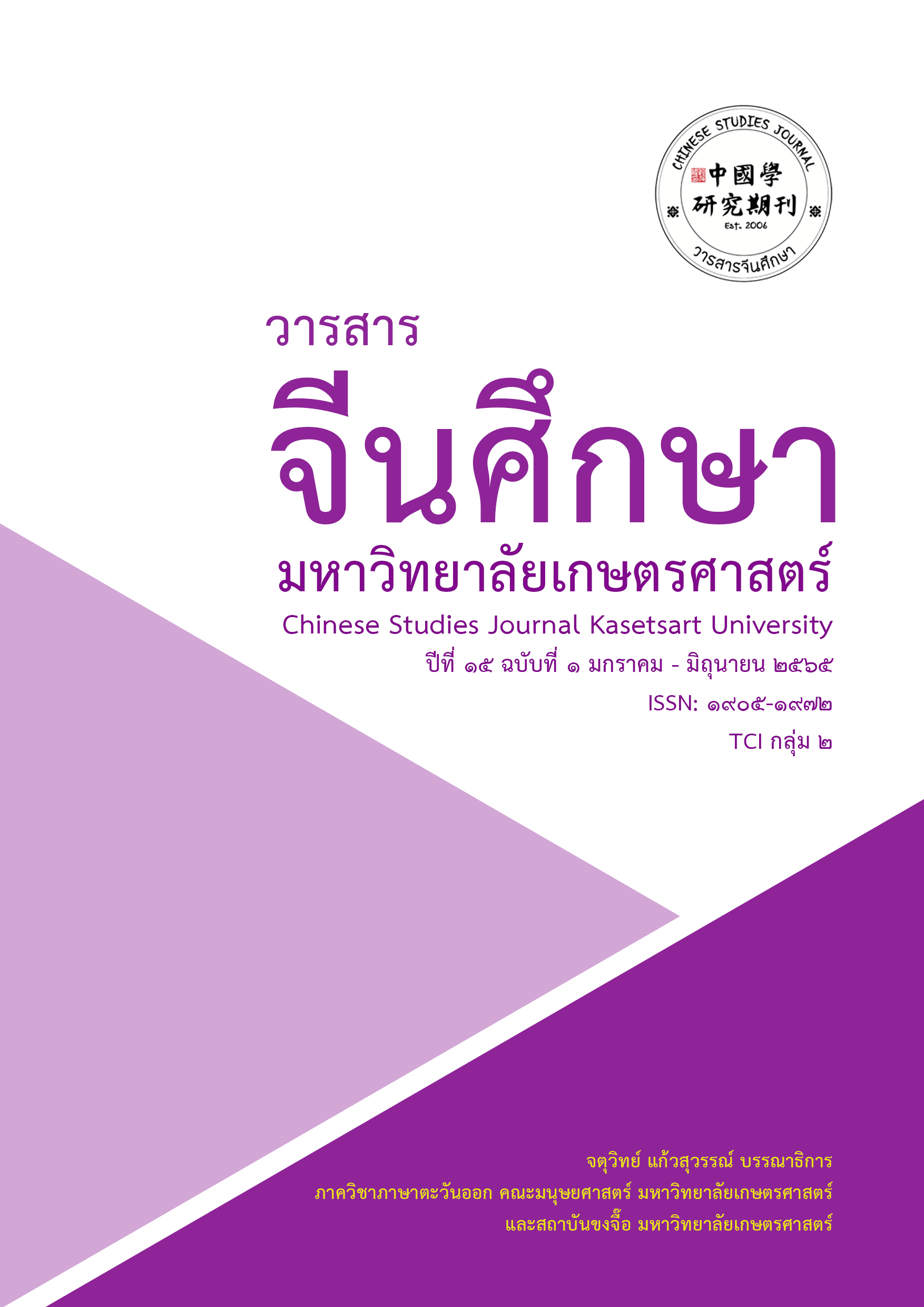The Error Analysis of Chinese Noun Phrase Usage by Thai College Students in the Upper North of Thailand การวิเคราะห์ข้อผิดพลาดในการใช้นามวลีภาษาจีนของนักศึกษาชาวไทยในเขตพื้นที่ภาคเหนือตอนบนของไทย
Main Article Content
Abstract
This research aims to classify the error in Chinese noun phrase usage by Thai college students in the upper north of Thailand and present the error's solution. Populations for this study were 290 college students majoring in Chinese from 5 Universities in the upper North of Thailand using the Purposive Sampling Method and collecting the data by using tests and analyzing data by using the percentage. From this research, the error in Chinese noun phrase usage can be separated into three categories: misordering, replacing noun phrases by using other structures, and addition. The highest percent error is the error of misordering. The second is the error of replacing noun phrases by using different forms, and the last is the error of addition. The main reason for these problems is The Influence of the Native Language. From these problems, the suggestion is to compare noun phrase forms between Chinese and Thai to help student to understand about the different between these two languages, and construct Chinese to Thai and Thai to Chinese Translation exercises emphasizing noun phrases to help students build expertise in noun phrase usage and reduce the error of Chinese noun phrase usage for Thai learners.
Article Details

This work is licensed under a Creative Commons Attribution-NonCommercial-NoDerivatives 4.0 International License.
ผลงานทางวิชาการที่ลงตีพิมพ์ในวารสารจีนศึกษา มหาวิทยาลัยเกษตรศาสตร์ เป็นลิขสิทธิ์ของผู้เขียนหรือผู้แปลผลงานนั้น หากนำลงในวารสารจีนศึกษาเป็นครั้งแรก เจ้าของผลงานสามารถนำไปตีพิมพ์ซ้ำในวารสารหรือหนังสืออื่นได้โดยมิต้องแจ้งให้ทราบล่วงหน้า แต่หากผลงานที่ได้รับพิจารณานำลงในวารสารจีนศึกษา เป็นผลงานที่เคยตีพิมพ์ที่อื่นมาก่อนเจ้าของผลงานต้องจัดการเรื่องปัญหาลิขสิทธิ์กับแหล่งพิมพ์แรกเอง หากเกิดปัญหาทางกฎหมาย ถือว่าไม่อยู่ในความรับผิดชอบของวารสารจีนศึกษา มหาวิทยาลัยเกษตรศาสตร์ ทั้งนี้ ความคิดเห็นต่างๆ ในบทความเป็นความคิดเห็นส่วนตัวของผู้เขียน ไม่เกี่ยวกับกองบรรณาธิการวารสารจีนศึกษา มหาวิทยาลัยเกษตรศาสตร์
References
วรวรรธน์ ศรียาภัย. (2556). ภาษาศาสตร์ภาษาไทย.นนทบุรี: สำนักพิมพ์สัมปชัญญะ.
กิตติธน ยงประพัฒน์. (2553). การศึกษาการเรียนรู้หน่วยขยายซับซ้อนในภาษาจีนกลางของนักเรียนไทย.วารสารจีนศึกษา, 3(3).
ชัชวาล ศรีทอง. (2558). ข้อผิดพลาดทางไวยากรณ์ภาษาสเปนในอนุกรมวิธานกลยุทธ์พื้นผิว : กรณีศึกษาวิชาการเขียนภาษาสเปนของนักศึกษาไทยระดับมหาวิทยาลัย.มนุษยศาสตร์สังคมศาสตร์, 11(1).
หลี่ ซุนเสี่ยวและจินตนา พุทธเมตะ. (2554). การศึกษาข้อผิดพลาดการใช้นามวลีภาษาไทยของนักศึกษาจีน วิชาเอกภาษาไทย ชั้นปีที่ 2 มหาวิทยาลัยชนชาติกวางสี. วารสารศรีนครินทรวิโรฒวิจัยและพัฒนา, 6(12).
ราตรี ธันวารชร. (2516). ลักษณะของคำไวยากรณ์ในภาษาไทย.กรุงเทพมหานคร: จุฬาลงกรณ์มหาวิทยาลัย.
Dulay, H.C. Burt, M.K. and Kreshen, S. (1982). Language Two. New York: Oxford University Press.
Richards, J.C.and Schmidt, R. (2002). Dictionary of Language Teaching and Applied Linguistics. Pearson Education Limited. London: Longman.
蔡宝卫.(2014).泰国学生汉语中定语语序偏误研究.广州:华南理工大学。
鲁健骥.(1994).外国人学汉语的语法偏误分析.语言教学与研究,第1期。
房玉清.(2008).实用汉语语法(第二本修订版).北京:北京语言大学 出版社。
吕叔湘.(1980).现代汉语八百词.北京:商务印书馆。
刘珣.(2015).新实用汉语课本第二版.北京:北京语言大学出版社。
刘月华.(2001).使用现代汉语语法.北京:商务印书馆。
王力.(1943).中国现代语法.北京:商务印书馆。
杨寄洲.(2006).汉语教程第一册.北京:北京语言大学出版社。
杨寄洲.(2006).汉语教程第二册.北京:北京语言大学出版社。
张敏.(1998).认知语言学与汉语名词短语.北京:中国社会科学出版社。
朱德熙.(1982).语法讲义.北京:商务印书馆。


